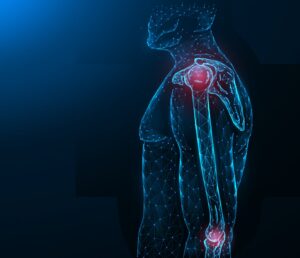Topical Pain
Prescribers and patients often desire to treat pain using topical medications in order to avoid narcotics or other oral medications. Sadly, topical pain medications have sometimes been a source of fraud, waste and abuse concerns as some medications prescribed and dispensed (both compounded and commercially available) are clinically questionable, incredibly expensive, or both.
Additionally, compounded topical pain creams often come with an additional stigma of “will it effectively penetrate through the skin?”
A patented compounded topical pain cream containing Diclofenac Sodium 1.5%, Lidocaine 2.5% and Prilocaine 2.5% addresses all of these issues. From a data standpoint, there are numerous journal articles discussing these ingredients used topically which can be accessed at the bottom of this page.
Regarding the question of “will it effectively penetrate through the skin,” a validated permeation study which is also available at the bottom of this page addresses that question. This permeation study, performed in conjunction with Eagle Analytical and PCCA, validates that these three drugs, used specifically in a patented formulation, will penetrate through the skin as desired. It’s not theoretical that it will penetrate – it has been confirmed.
CMPD Licensing, LLC (“CMPD”), the holder of numerous patents surrounding pain management and anti-infective medications (among other things) desires that this patented compounded topical pain management cream be available to prescribers and patients nationwide. CMPD currently licenses pharmacies that serve all 50 states.
CMPD is open to making additional licenses available for this patented formula available to any pharmacy desiring the same through a licensing agreement with CMPD.
If you are, or know, a prescriber or pharmacy who wishes to provide this for patients they serve, they also can contact CMPD directly by going to www.cmpdlicensing.com.
CMPD holds numerous issued patents including, but not necessarily limited to, the following:
- US Patent 8,327,610
- US Patent 8,464,498
- US Patent 8,663,663
- US Patent 8,895,036
- US Patent 9,078,853
- US Patent 9,186,319
- US Patent 9,271,989
- US Patent 9,468,599
- US Patent 9,468,601
- US Patent 9,592,241
- US Patent 9,707,229
- US Patent 9,717,748
- US Patent 9,724,294
- US Patent 9,724,315
- US Patent 9,925,141
- US Patent 9,962,391
- US Patent 9,999,604
- US Patent 10,064,949
- US Patent 10,105,342
- US Patent 10,105,381
- US Patent 10,231,924
- US Patent 10,434,115
- US Patent 10,525,025
- US Patent 10,610,503
- US Patent 10,617,703
- US Patent 10,660,962
- US Patent 10,792,296
- US Patent 10,813,897
- US Patent 10,813,908
- US Patent 10,898,455
- US Patent 10,898.491
- US Patent 10,966,946
- US Patent 10,973,804
- US Patent 11,173,163
- US Patent 11,207,336
- US Patent 11,213,500
- US Patent 11,213,501
- US Patent 11,278,508
- US Patent 11,278,590
- US Patent 11,311,564
- US Patent 11,324,694
- US Patent 11,446,236
Studies and Supportive Documents
Skin Permeation and Deposition Study
If you have any questions regarding this information, please feel free to contact CMPD Licensing, LLC.
No compounded medication is reviewed by the FDA for safety/efficacy.
©CMPD Licensing, LLC dba Kingdom Licensing
Website Design by Storey Marketing
The content and photographs on this website are copyrighted or licensed material and may not be downloaded for other than personal use. Retransmission, republication, reproduction or any other use of the content or photographs is prohibited.



